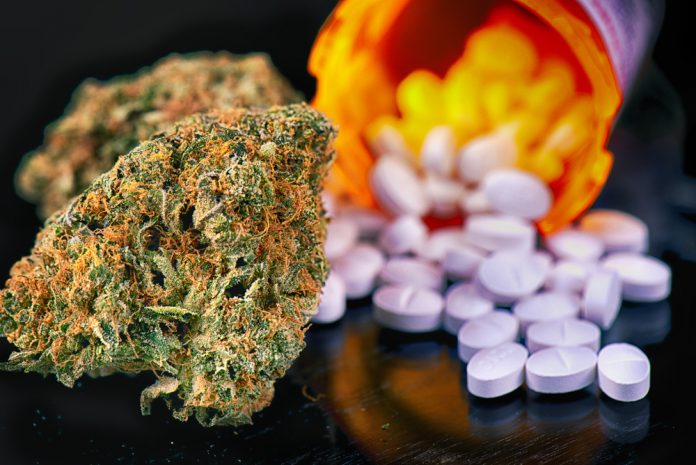As far as the cannabis industry is concerned, big pharma remains arguably the biggest threat. But does it go the other way around? Is cannabis ever a threat to big pharma? In a world where money is power, the pharmaceutical industry certainly outnumbers the cannabis industry. And overall, the pharmaceutical industry has political influence that could possibly be used against the cannabis industry. We witnessed something like this in Arizona, where pharmaceutical company, Inysys, donated half a million dollars to anti-legalization campaigns.
In any case, does the pharmaceutical industry have something to worry about? Studies have been conducted on how the legal cannabis industry has affected big pharma, and while the numbers don’t suggest any drastic upheaval in the pharmaceutical industry, big pharma nonetheless remains defensive. On top of this, there are a lot of political nuances that are hard to investigate without becoming deeply involved in media, propaganda, and conspiracy.
At the end of the day, politics and money are ultimately the way in which cannabis affects big pharma. Politically and socially, big pharma doesn’t have a great reputation right now, and ultimately, there are multiple points where the cannabis industry might steal a slice of big pharma’s proverbial pie. We’re going to have a look at the political and economic weak points of the pharmaceutical industry and how cannabis is affecting them.
Cancer drugs are big pharma’s biggest cashpoint
In 2018, as well as in 2017, cancer drugs topped the list as the highest selling pharmaceutical drugs in the country. Six of the top 15 selling drugs are for the treatment of different kinds of cancers, according to Gen’s list of 2018 best sellers. Myeloma, melanoma, breast cancer, colon cancer, and lung cancer are among some of the cancer types that are treated with these top-selling drugs. Immunotherapy drugs also make the list.
To put things in perspective, a total of somewhere in the vicinity of $45 billion worth of pharmaceutical cancer treatment was sold in 2018 (the combined sales of Rituxan, Avastin, Herceptin, Keytruda, Opdivo, Revlimid). It’s definitely not spare change. And with a lot of media sensationalizing CBD and THC’s cancer-fighting effects, there is a lot of potential for damage by the cannabis industry.
Cannabis, opioids and the chronic pain revolution
Big pharmaceutical companies have been heavily criticized for America’s opioid epidemic. On average, 130 Americans die per day as a result of opioid overdose. Most often, opioids are prescribed as a treatment line for chronic pain, the most common ailment for an American to seek pharmaceutical intervention for. Millions of prescriptions are fulfilled every year for pharmaceutical opioids.
But there is a huge nuance here to contend with. While the pharmaceutical industry admits that there is a threat of addiction when it comes to opioid medication, there are a lot of cultural issues which enter the picture. For example, the majority of opioid deaths since 2013 occurred as a result of illegally obtained pharmaceutical opioids, especially those containing illicitly manufactured fentanyl. In fact, between 2006 and 2017, there was a 19% reduction in the rate of opioid prescription.
In one 2014 study, Bachhuber et al. concluded that legal cannabis could have a role to play in reducing opioid deaths. Despite the nuances, researchers found statistically significant lower opioid overdose rates in states with legal cannabis policies. These lower rates of overdose keep strengthening over time. However, it is not understood how cultural factors might play a role in opioid overdose and its development as an epidemic, and certain demographics might be more at risk. This study did not investigate these subtleties.
Chronic pain is one of the two most common reasons for an American to self-medicate with cannabis. In fact, two thirds of Americans who sign in to a medical marijuana program are doing it for the treatment of chronic pain. On top of that, some Americans are using cannabis as a means of weaning themselves away from their opioid addictions.
With all of this in mind, the media has had a huge impact in painting the image of big pharma as a villain, using the opioid crisis as the main driver. This is one of those nuances we’re talking about. The media’s role in portraying big pharma as the culprit of the opioid epidemic, along with the fact that cannabis actually poses a real way for Americans to come out of this crisis, makes the chronic pain and opioid aspect a huge point of threat for the pharmaceutical industry.
Cannabis as an alternative, and its impact on big pharma
One particular study highlights the possibility of cannabis as an alternative medicine having an impact on big pharma’s revenue. In Bradford and Bradford’s analysis, researchers looked at the relationship between legal medical cannabis and the number of prescriptions filled for conditions that could otherwise be treated with medical cannabis. They found that where medical marijuana was available as an alternative, the use of prescription drugs fell significantly. The legalization of cannabis has led to different prescribing patterns and overall, a national reduction in the amount of money spent on Medicare. According to Green Health Docs, patients should have easy access to medical cannabis as an alternative to traditional pain medications, antidepressants, anti-anxiety medications, and other addictive and harmful drugs. This is the way to combat the nation’s opioid epidemic.
Basically, where cannabis is available, there is a demographic of Americans who are choosing it over pharmaceutical medication. Plus, cannabis as a single medicine can treat many more conditions than any other single pharmaceutical drug. It means there is potential for the cannabis industry to chip away at a lot of different pharmaceutical medications, whether they are for cancer, inflammation, Crohn’s, arthritis or chronic pain.
It’s also important to acknowledge that medical cannabis is gaining more and more validity every day. The research being pumped into CBD, THC and other cannabinoids validate many of the claims of CBD enthusiasts. Its anxiolytic, analgesic, anti-inflammatory, and anti-proliferative qualities have been researched in depth now, and it is slowly securing its position in the world of modern natural medicine. In fact, the cannabis industry is already producing pharmaceutical-grade cannabis medicines with the assistance of the pharmaceutical industry. GW Pharmaceuticals’ Sativex is one such example. These pharmaceutical grade medical cannabis products are made with near-pure cannabis extracts such as CBD isolate and distillate.
However, all of this isn’t to say that the cannabis industry and big pharma have to be at war. GW Pharmaceuticals is one example of a pharmaceutical company taking advantage of the cannabis revolution. GW has invested a lot of money into the manufacture of cannabis-based medicines (with real cannabinoids, not synthetic ones) and into the research of these products. It’s obvious that GW wants to manufacture pharmaceutical-grade cannabis products and take advantage of both worlds. And so far, they have been extremely successful with products like Sativex.
Is big pharma affected by cannabis? Well, of course. It’s a novel medicine that a lot of Americans are chasing for its potential to treat a huge variety of conditions. Big pharma is absolutely affected. But are they affected in a way that warrants defensiveness? That’s a whole different matter. Big pharma is still worth a lot more than cannabis, and to be honest, big pharma has more potential for taking advantage of cannabis than the other way around. Big pharma can use the innovations of the cannabis industry in much the same way that GW Pharmaceuticals has. At the same time, cannabis has the potential to damage the paycheck of some pharmaceutical companies, even if it’s just by a fraction.
Find a Home-Based Business to Start-Up >>> Hundreds of Business Listings.



















































